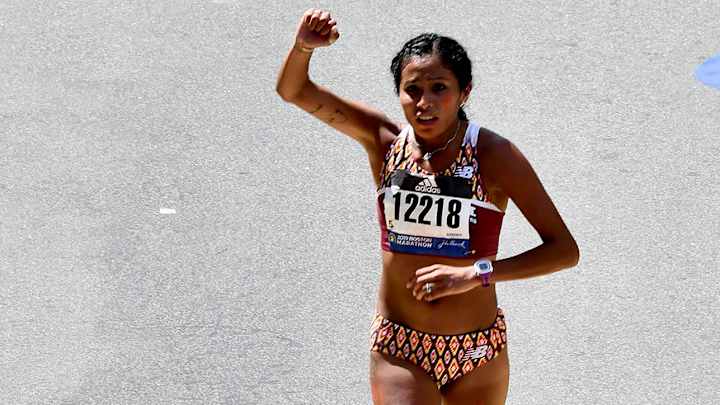Q&A: Jordan Daniel on Raising Native American Awareness Through Running, Boston Marathon 2019

Jordan Marie Brings Three White Horses Daniel was born to run.
Growing up Kul Wicasa Lakota, Diné (Navajo) and a citizen of Kul Wicasa Oyate (the Lower Brule Reservation in South Dakota), Daniel picked up the sport when she was just ten years old. Her grandfather Nyal Brings was a long distance runner for the University of South Dakota and was inducted into the school’s Hall of Fame for his accomplishments. Her mother was a sprinter who was training for the 1988 Olympic Trials and her grandfather’s friendly rival was Billy Mills, the 1964 10K Olympic Gold Medalist.
But Daniel wasn’t always keen on following in their footsteps. After running her first half-mile uphill, Daniel wasn’t sure she would ever enjoy the sport. She could tolerate it, she decided, but couldn’t love it. And then she found her purpose.
After running at the University of Maine, Daniel was approached by Mills ahead of the 2016 Boston Marathon with the opportunity to represent and raise funds for American Indian youth, helping Daniel realize there was a way to advocate for Indigenous people through sport.
Daniel has been utilizing that avenue since. In 2016, she organized the Run for Water Rally, a two-mile run from the Supreme Court to the U.S. Army Corps of Engineers to protest the Dakota Access Pipeline. In 2018, Daniel ran the San Diego Half Marathon in honor of Missing and Murdered Indigenous Women (MMIW), painting a red hand on her face and using big red letters on her legs to bring awareness to her cause.
And at this year’s Boston Marathon, Daniel continued that tradition, running on behalf of MMIW and her grandfather, who passed away in 2016, while also working with Wings of America to connect Indigenous youth with the Boston community.
Daniel caught up with Sports Illustrated to discuss the race, her activism, the newfound purpose running has given her, and more. This interview has been edited and condensed for clarity.
Sports Illustrated:What was your experience like transitioning from living on a reservation to living in Maine?
Jordan Daniel: I lived on the reservation until I was nine years old, and honestly it’s two different worlds. You have to learn how to still stay connected to back home, and you have to learn how to fit in in this modern, colonized world. Moving to Maine was the first time I ever experienced racism. I felt so alone and isolated. I wanted to fit in so badly, and for a time, I did not like who I was and the color of my skin. It wasn’t until college that I accepted myself and said, “This is who I am, and this is who I’m meant to be.” That’s when things started to align.
SI:What role did your grandfather play in helping you accept who you were, both as a runner and as a Native American?
JD: I am very critical of myself, but he always told me I was doing a good job. He was so invested in me and was my biggest supporter, always talking about me and texting me with words of encouragement and advice before races. Even now, three years after he passed away, I feel him and connect with him in every stride.
SI: When did you first know that working on behalf of Indigenous communities was something you wanted to do?
JD: When I was in eighth grade, I knew I wanted to move to D.C. and help make policies and laws that would make things better for Indian Country. I tried that for a year, but it felt so demoralizing and defeating, and I realized I was on the wrong side of the work I wanted to be on. I went into grants management with the Administration of Native Americans under Health and Human Services. I was able to spend three years there helping fund and navigate programs for Tribal communities, and that was worthwhile and more fulfilling to me.
SI:When did it click that you could turn running into one of your passions by combining it with advocacy?
JD: During that whole time, I was running competitively under coach Daniel Green of New Balance but never really tied running and advocacy together. I ran the Boston Marathon in 2016 and that’s where I really began organizing on these frontline efforts to stop the pipeline and raise awareness, realizing that I could combine those things together.
AA:What is MMIW, and what the issue that it is trying to solve?
JD: MMIW is a movement that is working to end violence on Native women and Alaskan Native women within our communities and across borders. I moved to Los Angeles for a job that was focused on tribal communities, working with them on programs to try to identify their victims and find solutions to ending this violent and dangerous cycle. Indigenous peoples have not been getting the attention they need to really highlight what is going on in our communities. There is no federal government support in terms of tracking this data. Last year a report by Sovereign Bodies Institute founder and executive director Annita Lucchesi showed that out of 5,712 cases of missing indigenous women, only 116 were logged into the Department of Justice database. That’s a huge issue, and in a sense, that’s silencing the voices of those families who want to find their loved ones or need justice and healing to move forward.
SI:What is Wings for America, and how did you decide to represent both the organization and MMIW during the Boston Marathon this year?
JD: Wings of America is an organization whose goal is to build healthy communities through Native youth running initiatives. They’ve tied it into the Pursuit Program, which I was also helping fundraise for. That pursuit program brings five Native youth to Boston to run in the 5K that weekend but also gives them an opportunity to visit Harvard University. Since I was already there, a week before the race, I decided to update my racing uniform to be the color red, with the MMIW symbol and the words, "No More Stolen Sisters." But due to lack of time, we didn't hear back about being able to use the symbol I wanted until after the run. So instead, I decided to paint the red handprint over my mouth to signify breaking the silence about the violence happening with the women in our indigenous communities and raise awareness for our stolen sisters. I did research, found 26 names, and when the first mile started, I read one name out loud, said a prayer for her and her family, and tuned into the environment for the rest of that mile. I did that for 26 miles, and the last .2 to the finish, I said a prayer for my grandfather. It felt really good to end that race for him. I hope I’m making him proud, not only by crossing the finish line but also by the way I’m carrying Indian Country with me.
SI:How has the running community responded to that advocacy since the Boston Marathon? Has that helped reaffirm your belief that this is the right sport to do this sort of work through?
JD: The running community is one that I love and has always accepted me. I’ve never felt ostracized or different within this community, and that’s definitely helped me realize even more how running is a great platform to not only raise awareness of what you’re running for but also to connect our love of running to our love of the things we cherish so deeply. The running community is one of the first groups of people that would understand that connection. This also is a means to build trust and a collaborative relationship between Indigenous peoples and non-Native peoples. We have a long history of treaties being broken and land degradation, creating a lack of trust between Tribal communities and the government. This is a way for me to try and help build unity.
SI:What message besides the one MMIW stands for do you think you’re able to send by representing who you are through the races you run?
JD: I want to assert our presence and to show we’re still here. A lot of people have never met a Native American and think they belong only in textbooks. This is is an opportunity for myself and other Indigenous runners who are sponsored athletes and are just in this world and outdoor running environment to say, “Hey, we’re still here.” Enough is enough. We’ve been sitting on the backburners for too long, feel like we’ve been forgotten and are invisible, but we’re not taking it anymore. We’re putting ourselves out there, helping support other indigenous peoples and bringing them to a platform where their voices can be heard.
SI:Does it ever cross your mind that there may be Indigenous youth out there looking up to you? How have you embraced that role?
JD: Definitely, and it’s a thought that makes me nervous, but I do hope they can look at me and think, “I can do that too. Why can’t I have a seat at the table? Why shouldn’t my voice be heard?” I didn’t really have role models for myself who were Native American and trying to change the narrative on how we are viewed, so I hope that youth see this as proof that they can do that.
SI:What’s the next goal you have with regards to continuing to advocate and work with this population through running?
JD: My current racing singlet by New Balance is called Team Indigenous. I’ve had this idea since 2016 to build an online running community and serve as a coach of sorts to indigenous runners who want to do a couch to 5K or try their first trail run or run a marathon. My hope is to build health and wellness in our communities and help our people live active lifestyles within the goals of what they want, so I’ve been talking to various people to see how we can make that happen.
SI:What advice would you give to people looking to support your cause?
JD: Learn. Go on social media, Google it and learn about these issues. Find out if there are Indigenous groups in your community, or if you know there’s a reservation nearby, try to become a good ally and help them organize. Don’t overstep. Don’t overspeak. Help them get to a platform where their voices can be heard.
